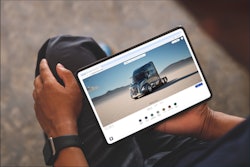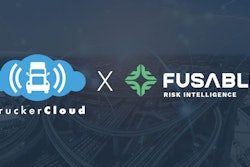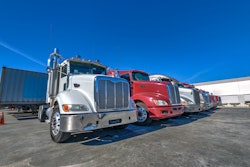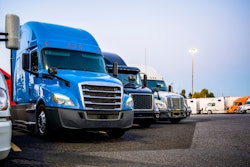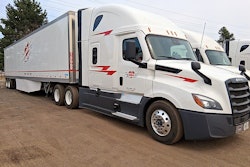On the surface, trucking seems pretty straightforward: assign the closest available drivers and equipment to orders, send drivers instructions, and watch pickups and deliveries go as expected.
Unfortunately, nothing could be further from the truth. Exceptions are the rule in this business. When they occur, critical details must be quickly communicated with drivers to mitigate the impacts.
Calling drivers or sending messages through traditional in-cab fleet mobility systems complicates matters. Drivers can lose track of details and respond slowly or not at all. Uncertainty and confusion mount whenever drivers need more information to resolve issues and do their jobs.
Many fleets now use custom mobile apps that give drivers organized, transparent, rapid communications to prevent and manage exceptions and keep their drivers moving.
Streamlined driver communication
Traditional in-cab fleet mobility systems give drivers one inbox for all corporate communications. Messages from dispatchers enter the same queue as those from safety, human resources, and other departments. A single communication channel may cause drivers to miss or ignore essential details.
Custom driver apps can solve this challenge by delivering messages through multiple channels that drivers can access through a single interface. For instance, a fleet could have one channel for general messages, another for company news, and a third for to-do tasks.
One way to ensure drivers receive priority communications is with text-to-speech functionality. Important messages can be automatically read to drivers while in motion. Meanwhile, drivers can view lower-priority company news or messages when safely parked.
Instead of scrolling through an inbox full of messages, drivers use their fleet’s app to quickly access priority items from personal and corporate devices, inside or outside the cab.
Simplifying trip planning
Fleets that use custom mobile apps can do more than send and receive essential communications. Apps that integrate with existing telematics and back-office systems can give drivers a single dashboard with one-click access to all their job tools, from truck-safe navigation to traffic and weather alerts, trailer locations, training content, performance and compliance data, and more.
The load planning and dispatch process is complete once drivers identify information crucial to their trip. Only drivers know their trip details, such as where to stop for fuel, rest breaks, maintenance, and other necessary tasks to deliver safely on time.
A custom fleet app can give drivers all the information they need to make trip-planning decisions. Fleets that use custom apps with an integrated trip-planning function can save office staff and drivers significant time and money.
A survey of truck drivers found they routinely spend at least 30 minutes each day on trip planning when using various smartphone apps for separate functions, like checking the weather, fuel prices, and planning route details.
A single interface can solve this disjointed process. A custom app can give drivers live traffic, weather, fuel, and other information on an interactive map display. It allows them to adjust their planned routes and add stops easily — within 15 minutes or less — to get the best possible results.
Fleets gain better visibility and more accurate shipment ETAs, while drivers spend more time behind the wheel to maximize their earnings. In addition, effective trip planning gives drivers more autonomy and control over their day, leading to higher driver satisfaction and lower turnover.
Weather alerts boost safety
We all know how weather can impact a driver’s day or week. K&B Transportation created a system that channels weather warnings through a separate newsfeed in its custom app. This helps the South Sioux City, Nebraska-based fleet, which has over 2,000 assets and is a leader in transporting perishable food products, improve safety and customer service.
“We put quick links to SafeTravel USA and other weather sites in the menu of our custom app so drivers are in tune with the weather and how long it’s going to last,” said Matt Fengler, an Operations Supervisor at K&B Transportation. “It’s improved our communication with our drivers. They appreciate that we're trying to communicate with them and doing what's in their best interest by keeping them in the loop as to what's happening.”
Before adding this feature, K&B’s operations department called each driver and alerted them of weather incidents and road shutdowns. It was a time-consuming effort.
Today, in their custom app, the weather alert feature takes over the application dashboard to notify drivers when a severe weather issue requires action. The alert is read aloud to help prevent driver distractions. The warning can result in the driver pulling over until the weather passes or re-routing out of harm’s way.
The driver must acknowledge the alert before they can access the dashboard's features menu. This ensures the message is noticed and addressed, and more importantly, it positively impacts safety.
“Being able to deliver that information quickly has reduced our DOT recordable accidents by about 80%,” noted Fengler. The alerts also help office teams proactively communicate with customers about when their product will arrive or where it is along its route.
“We can relay delivery changes to customers, speed up getting everybody back on the road, and ensure products are delivered safely,” Fengler added. “It’s been a game-changer.”
Custom apps: Driving success
Truckload operations demand real-time, efficient communications to manage exceptions. Traditional approaches create driver confusion and delays. Custom mobile apps streamline communications and improve safety by enabling drivers to make quicker, more informed decisions.
Traditional in-cab communication systems hold drivers and fleet operators back in an industry where every minute counts. Drivers benefit from having a single interface to access trip planning, communication tools, and centralized information from multiple sources, inside and outside the cab. Fleets also benefit from the positive impact on driver productivity, fleet safety, compliance, and profitability. And it’s all made possible through a custom mobile driver app.



